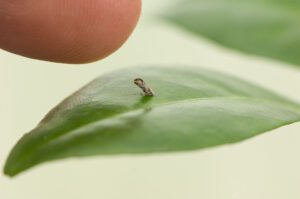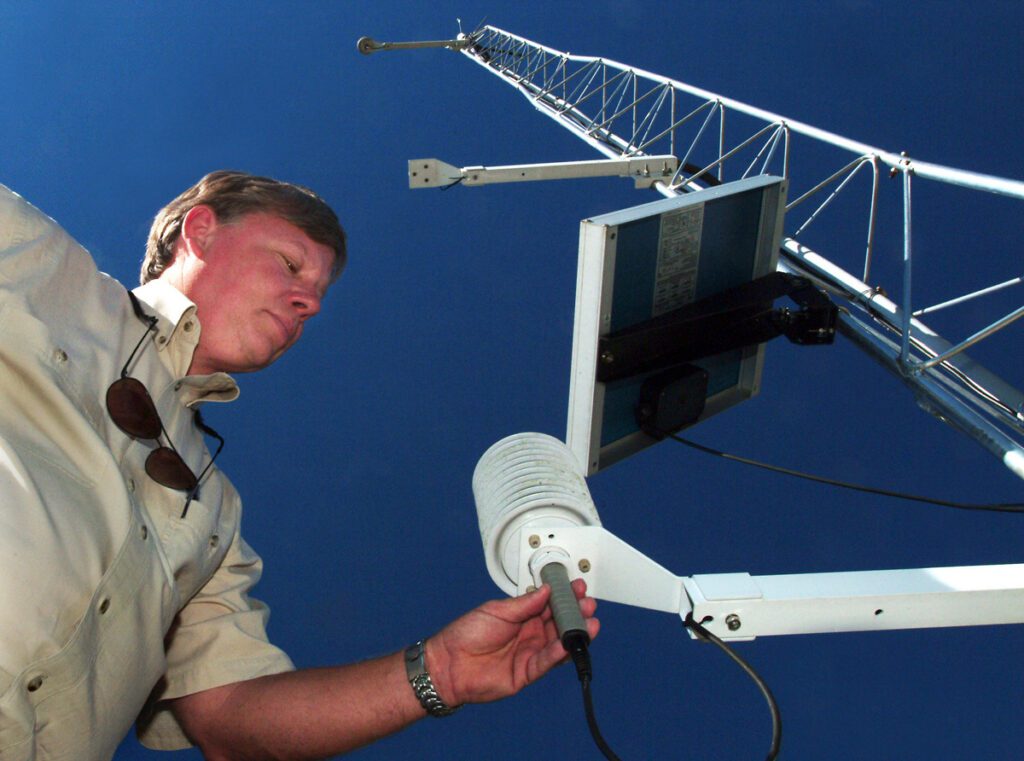Technologies that Conserve Water, Monitor Weather, and Aid in the Fight against Citrus Greening
Technology that has been used to help humans defeat disease is now being used to cripple the Asian psyllid, which is the pest spreading the dreaded citrus greening disease. In the greenhouse, Dr. Nabil Killiny, an assistant professor of Entomology for the University of Florida (UF), has been able to silence genes that enable the psyllids to fly and eat, which causes them to die faster.[emember_protected custom_msg=”Click here and register now to read the rest of the article!”]
Using the same therapy that won the Nobel Prize in Physiology or Medicine in 2006, Dr. Killiny has found a way to debilitate and destroy the psyllid in a strictly controlled environment. He then viewed the insects with Computerized Tomography (CT) scans to verify the malformations. At present, he is working to develop a border plant that will protect commercial citrus, which has an annual economic impact of $9 billion in Florida.
Dr. Killiny’s research involves making molecular modifications to a plant that would attract the psyllids (thus drawing them away from citrus groves, especially if these plants could border the farms), and silence the pests’ genes upon feeding on the plant. In his controlled experiments, the pests experience genetic malformations that either cripple them or decrease their ability to fly or feed on other trees. Hence, in theory it would decrease the number of sprays needed to protect the citrus groves— and over time— decrease the population of the psyllids and the associated spread of citrus greening disease. “I can’t say when it’s going to be available,” Dr. Killiny points out, but he hopes to have a suitable plant in a year.
“Right now it’s working great . . . in the lab,” says Dr. Killiny, who works at the Citrus Research and Education Center (CREC) in Lake Alfred. “However in the field, the control is very difficult.” Another part of the study involves making sure that this plant would not harm any bugs or species that are helpful to Florida groves, such as honeybees. “We really need to see if this technology can face all these challenges and work,” he adds.

Tiny to the naked eye, the adult Asian citrus psyllid is no bigger than a common gnat and feeds with the posterior of its body raised. Photo by R. Anson Eaglin, APHIS
Citrus greening disease, also known as Huanglongbing or HLB, was discovered in southern Florida about eight years ago. Some $70 million has been invested in research to defeat the disease, which has proved itself to be more challenging than freezes, hurricanes, canker, and nematodes.
Researchers like Dr. Killiny have been working towards a solution, or at least to control it, until a cure is discovered. “I’m trying hard to get all the permissions,” he says. “There are no guarantees yet that we will have these [border] plants . . . It is promising. It is very promising.”
The research and findings of Dr. Killiny, however, are just one possible solution to the threat of the disease. Scientists’ efforts have been broad-based and creative. Dr. Bill Dawson, J.R and Addie S. Graves Chair at CREC, gives one other example of continued research: “Visual genes like the fluorescent protein from jellyfish could be attached to bacterium to better understand how it causes disease in plants.”
Another researcher is seeking $2 million in state funds to improve pesticide applications to combat the psyllid. Nicole Williams, chief executive officer of Cape Coral’s Application Dynamics, is planning to develop a ground applicator that would cut pesticide costs by using less— and “softer”— pesticides. “I think there’s a better alternative,” says Williams, who hopes to have an apparatus to sell in one and a half to two years.
The battle against citrus greening, efforts to conserve water, and monitor the weather all have benefited significantly from this digital age. No longer do growers have to rely on weather data from the airport or telephone hotlines. They can install their own weather station, and capture the data remotely on their smartphones and computers. They can use technology to fine-tune fertilizer applications. And they no longer have to rely exclusively on overhead sprinklers. They can water plants with special mats that prevent overwatering and runoff.
Freeze protection is one area where growers can save a lot of water— and aggravation— by investing in an automated alert system. While freeze control is fairly new in Florida, it works “really well,” Williams says. The system can be programmed for texts, phone, light, and siren alerts.
The state is looking to provide more refined data this year to help with freeze control. “We’re constantly looking for ways to help growers,” says Rich Budell, director of Office of Agricultural Water Policy for the Florida Department of Agriculture and Consumer Services (FDACS).
Its cost-share program enables eligible growers to install a local weather station for 25 percent of the cost. “Rather than being on a fixed schedule, this allows them to have access to real-time weather data and soil moisture data to refine their irrigation strategies,” he says. “That also saves water.” Through its evaluations and upgrades, the state has saved some 50 million gallons of water a day.
In a separate program, FDACS has teamed up with the Southwest Water Management District to save water through its Facilitating Agricultural Resource Management Systems (FARMS) Program. The public-private partnership is working towards agricultural best management practices (BMP) that improve water quality/ecology and protect the aquifer.
Groundwater is conserved through automated pump and valve control, soil moisture sensors, and weather stations. “We estimate that precision agricultural components generally save between five and 10 percent of supplemental irrigation water use,” explains Carole Estes, a FARMS program geologist with SFWMD in Sarasota.
Equipment varies with crop, size of the farm, and the type of irrigation. “The precision agriculture equipment, when compared to excavating a reservoir and installing a pump station, is relatively cheap. Our average project cost is about $100,000, but that includes some rather large projects. It works out to about $124 / acre,” Estes reports.
Water also is being conserved through the Florida Automated Weather Network (FAWN), which provides weather data online. The data is used for “crop specific irrigation scheduling,” says Rick Lusher, FAWN’s director. “Growers can save two hours of water per cold event by using some of our information,” he continues. “Statewide that can be millions of dollars and billions of gallons of water saved in a given cold season.”
FAWN (which is funded by UF, water management districts, and the ag industry) has evolved from the small network of weather stations with a telephone hotline that it used to be in the 1990s. The network now includes sophisticated webservers that deliver data without a hitch, even during peak demand times to computers, smartphones, and tablets. “All of our weather stations, the way that they’re installed . . . the sensors that we use . . . meet the standard that the National Weather Service has for official weather,” Lusher adds.
Technology has evolved so growers can be on vacation and remotely check their irrigation system when there’s a problem, says Sonya Carns, president of Immokalee-based Ag-Tronix. Base systems can be expanded with new features and live notification 24 hours a day, seven days a week.
The biggest driving force behind using new technologies is the need to conserve water, says Kevin Locher, owner of Port Charlotte’s Locher Environmental Technology. “The technology has been there,” Locher observes. “Growers are getting to a point where they just need to use the technology that’s been available.” Technology allows crops to be watered when they need to be watered, rather than on a schedule. It also monitors fertilizer needs through soil salinity checks.
But sensors and weather stations are just part of the equation. “The key is you’ve got to get all this tied back to a central database,” says Rick Montney, vice president of Winter Haven’s ProPak Software, which markets a web-based agriculture application called LandMagic. “It’s one thing to do all the sprays . . . to be able to analyze that in a central database is critical.”
In addition to weather stations and sensors, special matting can help save water. It lets plants take as much, or as little, water as they need. They operate much like a dog’s water dish: through the soil’s capillary action, plants suck the water they need and leave the rest for future use. Water Pulse, a Longmont, Colorado, company with a Davenport office, offers matting watered manually or through an automated system to save 50 to 85 percent of the water, according to Doug Meek, the company’s field operations director. Additionally, it helps save on labor expenses. At approximately $2 a square foot, the system pays for itself, he says. Regular pots are used on top of the three-layered mat.
If the challenges of citrus greening, water conservation, and inclement weather are going to be solved in the digital age, it will not be in the absence of science and its ability to propel the industry into the future.
CREDITS
story by CHERYL ROGERS
[/emember_protected]

